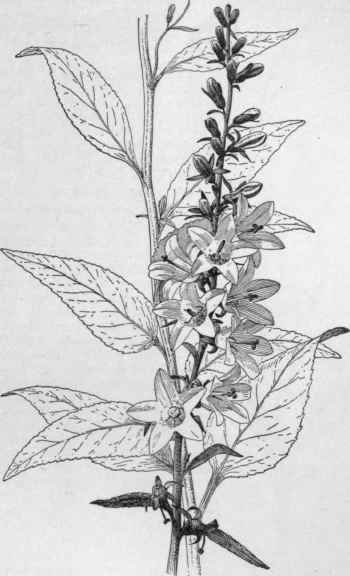Campanula. Part 6
Description
This section is from the book "The Standard Cyclopedia Of Horticulture Vol2", by L. H. Bailey. See also: Western Garden Book: More than 8,000 Plants - The Right Plants for Your Climate - Tips from Western Garden Experts.
Campanula. Part 6
21. Rapunculoides, Linn
Fig. 768. Perennial, 2-4 ft.: stem indistinctly pubescent or almost smooth: leaves rough, ovate-acuminate; root-leaves petiolate, cordate, crenulate; stem - leaves serrulate: calyx a little rougher than in C. Trachelium, the lobes linear-lanceolate, at length reflexed, one-fourth length of the oblong-campanu-late bright blue corolla; flowers soon declined or nodding, in long mostly 1-sided racemes or spikes, bright blue. Eu., Caucasus, Siberia, and common in patches on old roadsides and about yards. Summer. Gn. M. 14:9.

Fig. 768. Campanula rapunculoides. (X 5/8)
22. Versicolor, Sibth. & Smith
Perennial, 3-4 ft.; plant glabrous: stem ascending: leaves serrate; root-leaves long-petioled, ovate-acute, subcordate; stem - leaves short-petioled, ovate-lanceolate, acuminate: calyx-teeth acuminate, spreading, at length reflexed, one-half as long as the corolla: flowers in long, spicate racemes; style exserted: caps, spheroid. Greece.
ccc. Infloresence an open, compound panicle. 23. divaricata, Michx. Glabrous perennial, 1-3 ft.: stem erect, slender, paniculate above: branches slender, divergent: leaves sparse, subsessile, ovate-lanceolate, acuminate at both ends, coarsely serrate: calyx-lobes awl-shaped, one-half shorter than the tubular, bell-shaped corolla; flowers small, nodding, pale blue, in a very open and compound panicle; style straight, exserted. Alleghanies, from Va. to Ga. - Rare in gardens.
Group III. Low-Growing Or Rock-Garden Campanulas, Mostly Less Than A Foot Or 15 In. High. Nos. 24-49
A. Calyx with an appendage at the base of each sinus, often minute or disguised in form.
B. Throat of corolla spotted violet.
24. Punctata, Lam. (C. Nobilis, Lindl.)
Named from the spotted whitish corolla, the purplish spots being inside and showing through faintly in the fresh flower but more plainly in the dried specimen: like C. alliar-iaefolia. Perennial, 1 ft., with long and loose hairs: upper leaves nearly sessile, and more sharply toothed than the lower: calyx-lobes one-third as long as the corolla, longer, looser and hairier than in C. alliariae-jolia, and the margins much more recurved: peduncle 1-4-flowered; flowers nodding; corolla cylindrical, 2 1/4 in. white, spotted within, strongly ribbed. Siberia, Japan. G.C. III. 38, supp. Aug. 26; 42:96. Gn. 73, p. 423; 75, p. 458. G.M. 51:781. G. 29:595- C. nobilis has been considered distinct. In F.S. 3:247 the corolla is dark violet without, the limb hairy, while in B.M. 1723 (C punctata) the corolla is white outside and not bearded. In F. S. 6:563 (C. nobilis variety alba) the limb is not bearded and the stem is red, and not hairy. The three pictures show great differences in foliage, pubescence and appendages. This is one of the most interesting of all campanulas, and is, unfortunately, usually considered more quaint than beautiful.
The spotted throat readily separates it from other campanulas.
25. Van Houttei, Carr
Perennial, 2 ft.: root-leaves long-petioled, roundish cordate, more or less lobed; stem - leaves sessile, oval-lanceolate, irregularly bi-dentate, 2 1/2-4 in. long, more or less villous, strongly nerved: flowers usually solitary, nodding at the end of a small branchlet, 2 in. long, half as broad, indigo-blue, or violet; calyx-lobes linear, spreading, 1 in. long. - A garden hybrid resembling C. punctata. Intro, into France 1878 by Thibaut and Keteleer. variety pallida, Hort., has pale lavender flowers
26. Allionii, VILL
Perennial, 3-5 in.: rootstock slender, creeping underground, sending up stems at intervals of 1/2-1 in leaves few, about 7 on a stem, 1-2 in. long, linear-lanceolate, sessile, slightly hairy, entire, midrib distinct, lower ones in a whorl of about 5, upper ones similar but more erect: calyx-lobes lanceolate, half as long as the corolla, the appendages ovate, reflexed, one-third the length of the calyx-lobes; flowers purple, with a rare white variety, only one on a stem, inclined or nodding, 1 1/2 in. long, and as broad across the mouth, probably the largest for the size of the plant of any campanula. A very local species, found only in the western Alps. B.M. 6588. G.C. III. 52:52. Gn. 60, p. 51.
cc. stems usually several-flowered d. Margin of corolla bearded.
27. Barbata, Linn
Perennial, 6-9 in.: stem pilose: leaves villous, entire or nearly so; root-leaves tufted, lanceolate; stem - leaves few, ligulate (?): raceme loose, 3-4-flowered; flowers nodding, pale blue; calyx appendage ovate, obtuse, half as long as the lobes; corolla bell-shaped, shorter than in C. Allionii, and with a bearded mouth. Alps. L.B.C. 8:788. G.C. III. 48:388. Gn. 48, p. 297. G.W. 12, p. 447. -There is a white-flowered form, but apparently no purple. Readily distinguished from C. Allionii by the different colored, bearded and smaller flowers, which are rarely borne singly, and by the dense, soft hairs of the stem Alps, 2,400-6,000 ft., widely distributed; mts. of Norway, and the Carpathians. Becomes coarse when grown in rich ground.
dd. Margin of corolla not bearded. e. Flowers erect.
28. Mellis, Linn
Perennial, velvety gray, 6-8 in.: stems procumbent, about 2-flowered: root-leaves tufted, obovate or spatulate; stem - leaves ovate or rotund: flowers loosely pani-cled; calyx-lobes lanceolate, erect, half shorter than the glabrous, bell-shaped corolla; appendages minute, shorter than the calyx-tube; corolla erect, dark purplish blue or lavender, with a white throat, the tube long, segments short, broad, spreading, acute. Spain, Crete. B.M. 404. - Rock or border plant. ee. Flowers nodding. 29. alpina, Jacq. Perennial, 3-8 in.: stem furrowed: leaves smaller than in C. barbata, more narrowly lanceolate, entire, hairy: flowers typically deep blue, bell-shaped, with broader and shorter segments than in C. barbata; calyx-lobes proportionately very long, surpassing the flower-bud, and nearly as long as the flower, but widely spreading. Alps of Austria, Lombardy and Transylvania, 6,000-7,000 ft. altitude. B.M. 957. J.H. III. 29:5. - There is a white-flowered variety The plant has a characteristic shaggy appearance from the hairy leaves Easy of cultivation
Continue to:


